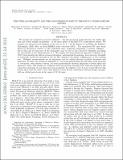THE STELLAR OBLIQUITY AND THE LONG-PERIOD PLANET IN THE HAT-P-17 EXOPLANETARY SYSTEM
Author(s)
Fulton, Benjamin J.; Howard, Andrew W.; Winn, Joshua Nathan; Albrecht, Simon H.; Marcy, Geoffrey W.; Crepp, Justin R.; Bakos, Gaspar A.; Johnson, John Asher; Hartman, Joel D.; Isaacson, Howard; Knutson, Heather A.; Zhao, Ming; ... Show more Show less
DownloadWinn_The stellar obliquity.pdf (407.1Kb)
OPEN_ACCESS_POLICY
Open Access Policy
Creative Commons Attribution-Noncommercial-Share Alike
Terms of use
Metadata
Show full item recordAbstract
We present the measured projected obliquity—the sky-projected angle between the stellar spin axis and orbital angular momentum—of the inner planet of the HAT-P-17 multi-planet system. We measure the sky-projected obliquity of the star to be $\lambda =19^{+14}_{-16}$ deg by modeling the Rossiter-McLaughlin effect in Keck/HIRES radial velocities (RVs). The anomalous RV time series shows an asymmetry relative to the midtransit time, ordinarily suggesting a nonzero obliquity—but in this case at least part of the asymmetry may be due to the convective blueshift, increasing the uncertainty in the determination of λ. We employ the semi-analytical approach of Hirano et al. that includes the effects of macroturbulence, instrumental broadening, and convective blueshift to accurately model the anomaly in the net RV caused by the planet eclipsing part of the rotating star. Obliquity measurements are an important tool for testing theories of planet formation and migration. To date, the measured obliquities of ~50 Jovian planets span the full range, from prograde to retrograde, with planets orbiting cool stars preferentially showing alignment of stellar spins and planetary orbits. Our results are consistent with this pattern emerging from tidal interactions in the convective envelopes of cool stars and close-in planets. In addition, our 1.8 yr of new RVs for this system show that the orbit of the outer planet is more poorly constrained than previously thought, with an orbital period now in the range of 10-36 yr.
Date issued
2013-08Department
Massachusetts Institute of Technology. Department of Physics; MIT Kavli Institute for Astrophysics and Space ResearchJournal
The Astrophysical Journal
Publisher
Institute of Physics Publishing/American Astronomical Society
Citation
Fulton, Benjamin J., Andrew W. Howard, Joshua N. Winn, Simon Albrecht, Geoffrey W. Marcy, Justin R. Crepp, Gaspar A. Bakos, et al. “The Stellar Obliquity and the Long-period Planet in the HAT-P-17 Exoplanetary System.” The Astrophysical Journal 772, no. 2 (July 9, 2013): 80.
Version: Author's final manuscript
ISSN
0004-637X
1538-4357